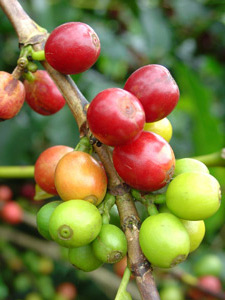Coffee plantations in the mountains of Colombia
In fact, according to Ms. Knudsen, people started drinking fine coffee, but later, due to the growing demand for coffee, the discovery and use of new coffee varieties led to the decline of coffee quality. later, people even began to dislike this bad coffee and began to turn to other drinks. In this case, Ms. Knudsen re-made people realize the value of boutique coffee, which led to a boutique coffee boom. In the United States, there are enterprises and stores in pursuit of boutique coffee represented by Starbucks. The market for boutique coffee is also growing. In the 1990s, with the rapid increase of boutique coffee retailers and cafes, boutique coffee has become one of the fastest growing markets in the catering service industry, reaching $12.5 billion in the United States alone in 2007. Now boutique coffee has become the fastest growing coffee market. Coffee producing and importing countries around the world are aware of the great potential of the boutique coffee market, and continue to make efforts to the production and production of boutique coffee.
Anchor point
Coffee plantations deep in the mountains
Having tasted authentic Colombian coffee, I would like to know more about the process of growing and producing coffee. In the past, because of the high incidence of various social problems, it was difficult for tourists to see pure Colombian coffee plantations for the sake of safety. In recent years, as the government has intensified its crackdown on violent organizations, more and more tourists have been able to see the coffee plantations deep in the mountains and witness the whole process of coffee production.
Colombian coffee plantations are mainly concentrated in the "Coffee Golden Triangle", that is, the triangle formed by Medellin, Armania and Manizarez. The coffee produced here accounts for the largest proportion of the national output and the best quality in Colombia.
I came to the Coffee Golden Triangle one morning. When the plane landed in Armania, the misty hills were green, and the morning light covered the green fields with golden tulle. The pick-up driver didn't wait for me to sit down before he flew to the scheduled farm. Along the way through the small towns and fields, filled with the smell of idleness, no speeding cars, no people on the road, livestock are also leisurely, aimlessly wandering, this is life in rural Colombia.
The driver told me that the "Golden Triangle" is actually a valley separated by the Andes from the Ecuadorian border into Colombia and the east-west branch. There is fertile soil formed after volcanic eruptions, with an average annual temperature of about 18 degrees Celsius and annual rainfall of 2000 to 3000 millimeters, making Colombia one of the few countries in the world that can harvest coffee all year round.
In Colombia, almost all coffee plantations are opened along the highlands of the mountains, and we drove into the mountains for a long time to reach our destination, the Agrado Coffee Farm. John, who received me, was a tall and handsome young man who was in charge of technical and management work here. He told me that the word "coffee" comes from the Greek word "Kaweh", which means "strength and passion". He said that although there is no specific record, it is now widely believed that Africa is the hometown of coffee, and when African slaves are sold to places such as Yemen and the Arabian Peninsula, coffee is taken to various places along the way. The history of coffee cultivation in Colombia can be traced back to the Spanish colonial era in the 16th century: some say it came from the island of the Caribbean and by water through El Salvador in Central America; others say that coffee beans were first introduced to Colombia by a priest from the French Antilles via Venezuela.
John took me to the shade of the manor. There, several little girls have prepared tables, chairs, utensils and other equipment, waiting for me to taste the coffee. They use different utensils to brew coffee, and let me taste it and compare it: the traditional filter paper method can taste the soft acidity of coffee; the siphon pot brewing method can more fully understand the characteristics of coffee; and the syringe pressure law squeezes out all the essence of the coffee, making it more mellow. In addition, they also showed me exquisite coffee utensils, as well as skillful coffee art such as washing and ironing cups.
Walking into the coffee plantation, I saw a lush green dotted with bright red coffee beans. John told me that the fruits would be shelled and soaked for another 18 hours after picking. The fruit of good quality will sink into the water, while those floating on the surface will be removed, fermented together with the shell and used as fertilizer. Colombia attaches great importance to environmental protection, and all recyclable materials are never wasted. In the end, the remaining coffee beans have to go through the steps of sun drying, air drying and screening.
Such a complex and delicate process makes the roasted Colombian coffee exudes a light and elegant aroma, which is not as warm and intense as Brazilian coffee, nor sour like African coffee, but a sweet fragrance with gentlemanly elegance and soft and smooth taste, so Colombian coffee is also called "green gold".
A place where "cards are not played according to reason".
In her travels, Taiwan's female writer San Mao describes Colombia as a place where "cards are not played according to rules." its citizens are enjoying leisurely coffee hours while experiencing social unrest, and its land is half covered with golden coffee and half with devil-like poppies. According to the time Daily, Colombia's largest media, 93% of the world's heroin is produced on the border between Colombia and Ecuador. The cultivation, processing, trafficking and transshipment of drugs is indeed the biggest headache for the Colombian government.
In 1927, the Government established the Colombian Coffee producers Association. This is a non-profit organization that serves Colombian coffee farmers and is the only official coffee professional guild in Colombia. For more than 80 years, it has protected the cultivation, technical training and financial support of Colombian coffee, as well as the spread of coffee culture, which has not only greatly improved social security, but also created Colombian coffee's reputation in the world. Therefore, it is also considered to be one of the most successful guilds in the world.
A friend who works at the Colombian Coffee producers Association told me that another duty of the association is to strictly control the export of coffee, "as long as the quality does not meet high standards, products are not allowed to be exported." Maybe for Colombians, coffee is a business card of the country.
The role of coffee is already apparent: last year, Colombia was listed as one of the top 10 happiest regions in the world by the British New economy Foundation. Many people don't understand this, but I'm not surprised at all. In my opinion, Colombians do know how to enjoy life very well: the pedestrian street in downtown Bogota is a literary paradise, where juggling and dancing artists can be seen everywhere; in the M á rquez Cultural Center, citizens quietly read the masterpiece "A hundred years of Solitude," while people who are tired of doing business or shopping will have a cup of coffee in the cafe, take a break, and have a chat....
Editor: Liu Guofeng (intern), Song and Yuan

Important Notice :
前街咖啡 FrontStreet Coffee has moved to new addredd:
FrontStreet Coffee Address: 315,Donghua East Road,GuangZhou
Tel:020 38364473
- Prev

What are the ingredients of coffee beans? what plants does coffee belong to?
After extraction, tannic acid will turn into a yellowish powder, which can easily blend into water, and after boiling it will decompose and produce pyrosylic acid, which will make the coffee taste worse, and if it is soaked and left for several hours, the color of the coffee will become thicker than when it was just soaked, and it is also less tasty, so there is a saying that it is best to finish it as soon as possible. The fat contained in coffee, which is extremely important in flavor.
- Next

What conditions do coffee trees need for planting? do they have high requirements on local climate?
The origin of the coffee tree is Ethiopia in Africa. In botany, coffee trees belong to the evergreen trees of the subgenus Rubiaceae, and coffee beans, commonly known as coffee beans, are the seeds of the fruit of coffee trees, just because they are shaped like beans, so they are called coffee beans. Climate is the decisive factor for coffee cultivation. Coffee trees are only suitable for growing in the tropics or subtropics, so latitude 25 is south and north.
Related
- Does Rose Summer choose Blue, Green or Red? Detailed explanation of Rose Summer Coffee plots and Classification in Panamanian Jade Manor
- What is the difference between the origin, producing area, processing plant, cooperative and manor of coffee beans?
- How fine does the espresso powder fit? how to grind the espresso?
- Sca coffee roasting degree color card coffee roasting degree 8 roasting color values what do you mean?
- The practice of lattes: how to make lattes at home
- Introduction to Indonesian Fine Coffee beans-- Java Coffee producing area of Indonesian Arabica Coffee
- How much will the flavor of light and medium roasted rose summer be expressed? What baking level is rose summer suitable for?
- Introduction to the characteristics of washing, sun-drying or wet-planing coffee commonly used in Mantenin, Indonesia
- Price characteristics of Arabica Coffee Bean Starbucks introduction to Manning Coffee Bean Taste producing area Variety Manor
- What is the authentic Yega flavor? What are the flavor characteristics of the really excellent Yejasuffi coffee beans?

